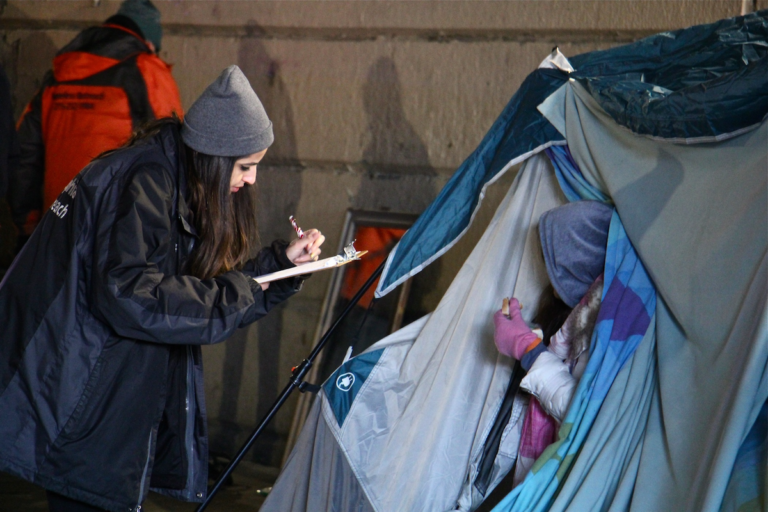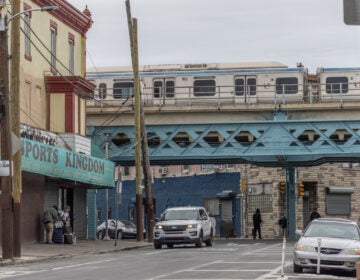Doing more good than harm: Conflicting feelings on the frontlines of harm reduction
Doing harm reduction work can feel like walking a tight line between helping and enabling.
Listen 11:48
An outreach worker gets information from a woman living in a tent under the Emerald Street railroad overpass. (Emma Lee/WHYY)
This story is from The Pulse, a weekly health and science podcast.
Find it on Apple Podcasts, Spotify, or wherever you get your podcasts.
When Joe Quinn started out working in harm reduction — he had his doubts.
“It was just so out there,” Quinn said. “I believed it as being, I’m enabling this person. I’m being okay with his lifestyle …Usually you’re going to kill yourself or end up in prison. Those are the end results, or just add more misery onto your life.”
Quinn is a certified peer specialist and treatment care manager in opioid interventions at Pathways to Housing in North Philadelphia.
His job comes down to helping people addicted to opioids work towards recovery, which means that sometimes, the best approach is minimizing the risks of substance abuse, rather than trying to force abstinence. That means letting people continue to use drugs.
This approach, called “harm reduction,” consists of health policies and practices that help to reduce the risk of drug overdoses and death. Its popularity is growing nationally as communities continue to fight the opioid crisis.
It’s also been met with skepticism and resistance, as many consider it supporting a person’s addiction.
From addiction to recovery
Opioid addiction is a world that Quinn knows personally.
He was born and raised in the Fairmount neighborhood of Philadelphia and has lived in the city for most of his life.
“I’m very Philly. I live, breathe, sleep, Philly,” he says.
When he was 16-years old, he started to experiment with Percocet to get high, and then things escalated quickly to OxyContin. And during the 1990s, which were the beginning stages of the opioid epidemic, that was a similar story for millions of Americans.
Then came heroin.
“You become addicted to heroin because you can no longer afford the OxyContin when you’re spending close to $200 a day on OxyContin,” he said. “And then you figure a $20 bag of heroin, give me the same high.”
Quinn suffered from an opioid addiction that lasted up until five days before his 35th birthday. He spent those years single and working at a construction company. The majority of his paychecks were supporting his addiction. He remembers just how alone he felt.
“There’s a lot of darkness. There’s a lot of pain that comes along with it,” he said. “Family don’t talk to you. Friends that were childhood friends no longer talk to you. You’re pretty much on your own. Just you and your addiction.”
Subscribe to The Pulse
He spent the better part of a decade in-and-out of treatment.
“I lost count a long time ago. I was like a revolving door in and out of detoxes, rehabs,” he said. “There’s not a detox or rehab in this city I haven’t been through. There used to be a hospital on Gerard Ave., Saint Joseph’s Hospital, who had a detox floor, and they knew me by first name basis.”
What changed for Quinn was when he started a methadone program and began volunteering at a local church. He handed out breakfast and clothes for the homeless every Saturday morning and started engaging with other people struggling with addiction.
When he finished the program, Quinn decided to become a certified peer specialist in 2011.
Helping others while in recovery
He spent the next following years working in Kensington – a Philly neighborhood that he used to “cop in” to buy drugs. Being stable in his recovery has been crucial.
“A lot of times you will see CPSs [certified peer specialists] relapse,” he said. “This job can be very triggering. It can take you back there really easily, especially when you’re out in the community in Kensington. I walk by many abandoned homes that I used to get high in. If you’re not secure in your recovery, it can be very tricky.”
Quinn says earlier on in his recovery there was a greater risk of relapsing. He said that being in recovery never stops and he has the support of his workplace.
“There’s been several times where I’ve called my supervisor when I’m out in the field and say, ‘Hey, I’ve got to get out of here,” he said. “Thankfully, I work at a place that respects my recovery and allows me to leave immediately if something doesn’t feel right.”
Since reentering the community, Quinn’s also observed overdoses increase more than when he was addicted.
“There’s been times we’ve lost so many participants where you say, ‘What are we doing?’,” he said. “Those are times too where it’s that inner battle with myself.”
But probably the most dramatic difference between his years of addiction and now is that people are using more than just heroin and fentanyl.
“Every six months, or six months to a year the drugs just keep changing,” he said. “Before fentanyl came you could spend $20 on actual heroin, do two $10 bags, and you would be fine to the next morning if you had to be, without experiencing any withdrawal symptoms.”
A new drug is now “tranq,” also known as Xylazine, which is a tranquilizer known for sedating animals. And Quinn says it’s virtually everywhere and causing a lot of damage.
“It’s just eating the flesh to the point where there’s, like, nothing on their arms,” he said. “You can see all the way down to the tendons, to the point where people get their arms and their legs amputated. It’s bad.”
And that’s how Quinn’s learned to embrace harm reduction.
He’s recognized that during the opioid crisis, as overdoses continue to rise, keeping people alive long enough to make the decision to seek treatment is a right everyone should have.
“Most people don’t want to die,” he said. “Something as simple as that is, can be a game changer when it comes to someone living and dying.”
And even though he occasionally feels conflicted about harm reduction, he says it ultimately achieves a different level of trust and being present with those struggling with addiction. It’s something that Quinn believes would have made a difference in his own life, if someone had been there with him, too.
“I actually wish that I knew about harm reduction when I was out there using,” he said. “I’ve presented different harm reduction tactics to participants, and they always look at me like I’m crazy. I had to start putting myself in their shoes and be like, ‘Yeah, when I was using, I probably wouldn’t have wanted to do that either.’”
Keeping connections to people is what’s most important to Quinn. He says that the field of opioid interventions needs more peer specialists, and people who walk-through neighborhoods doing outreach. He understands that harm reduction might always be controversial for many, but in the end, it’s about helping to improve the lives of people that matter most.
“I would tell people if they questioned harm reduction or why we do it, tell them to go to Kensington Ave., go to McPherson Park,” he said. “Just sit on the curb and talk to a few of the people out there that are for opioid users. Get to know them, hear their story, and kind of get a sense of why they’re in this position. I think once they hear their stories, they will look at it a little differently.”
Support for WHYY’s coverage on health equity issues comes from the Commonwealth Fund.
WHYY is your source for fact-based, in-depth journalism and information. As a nonprofit organization, we rely on financial support from readers like you. Please give today.






